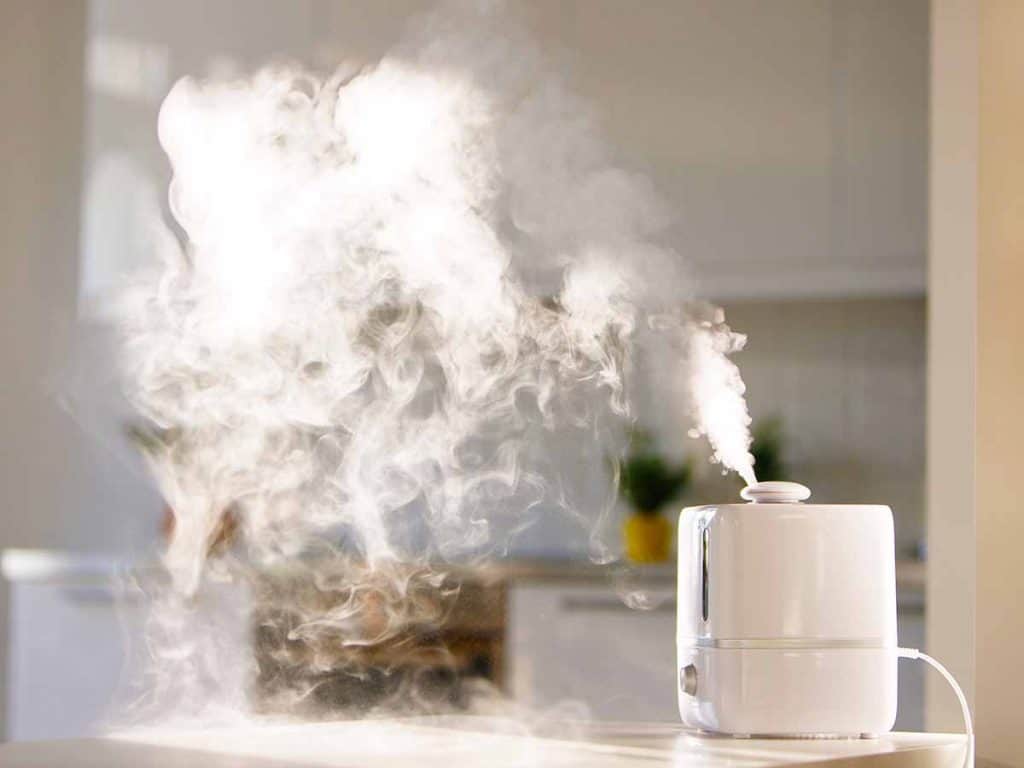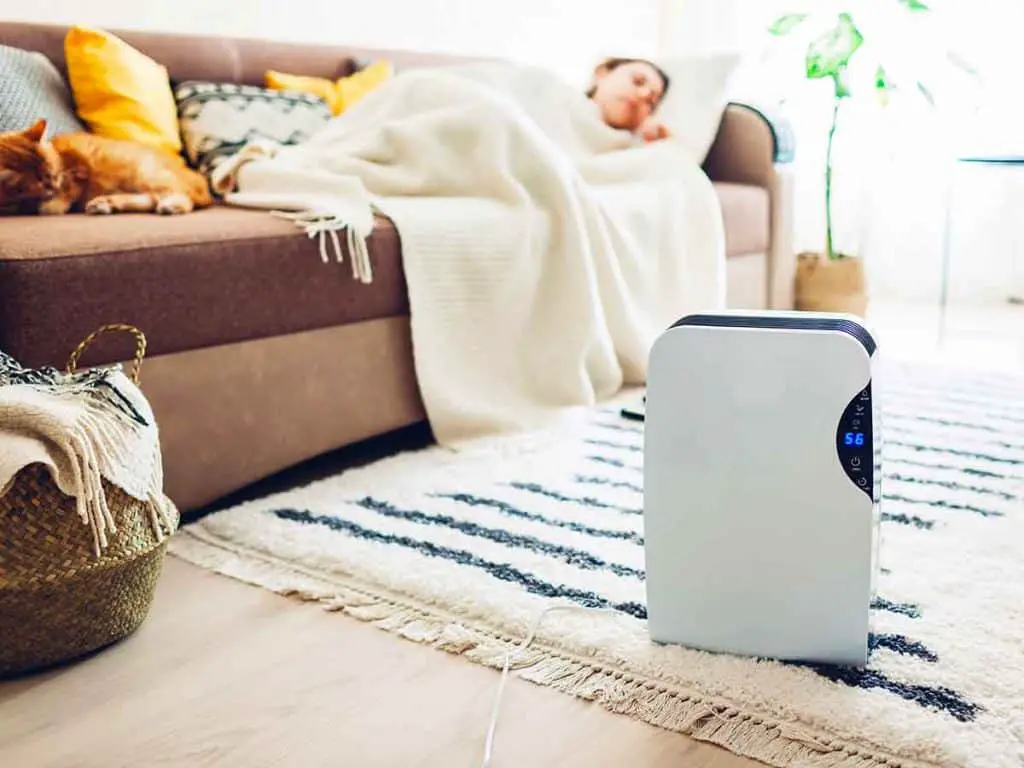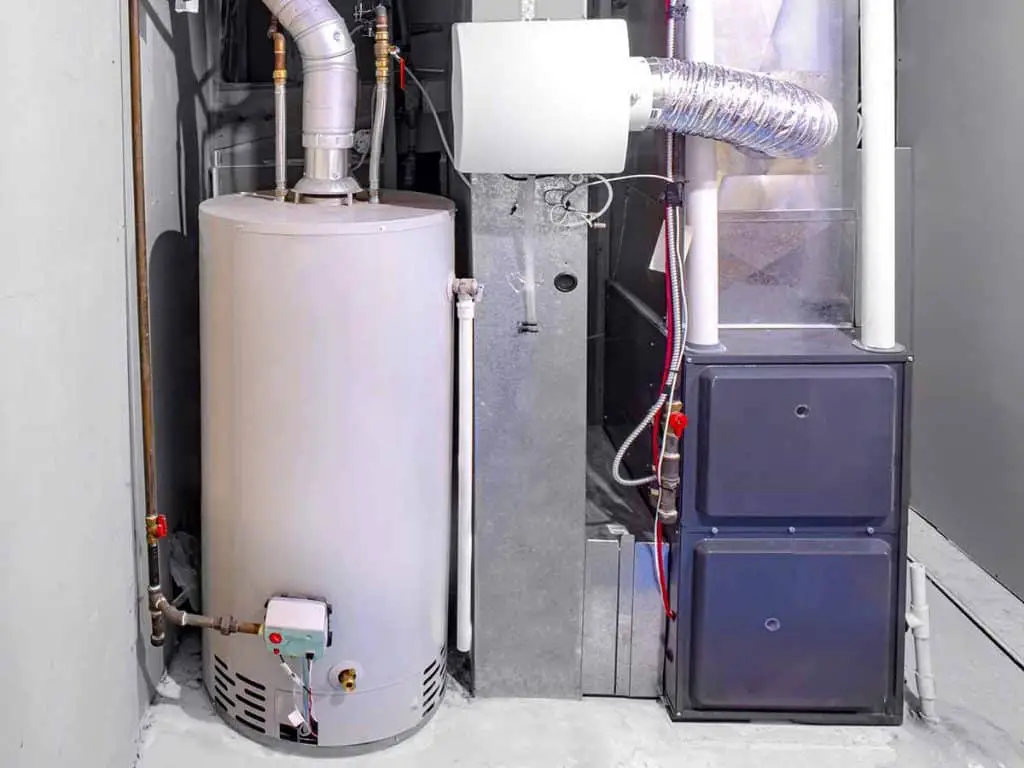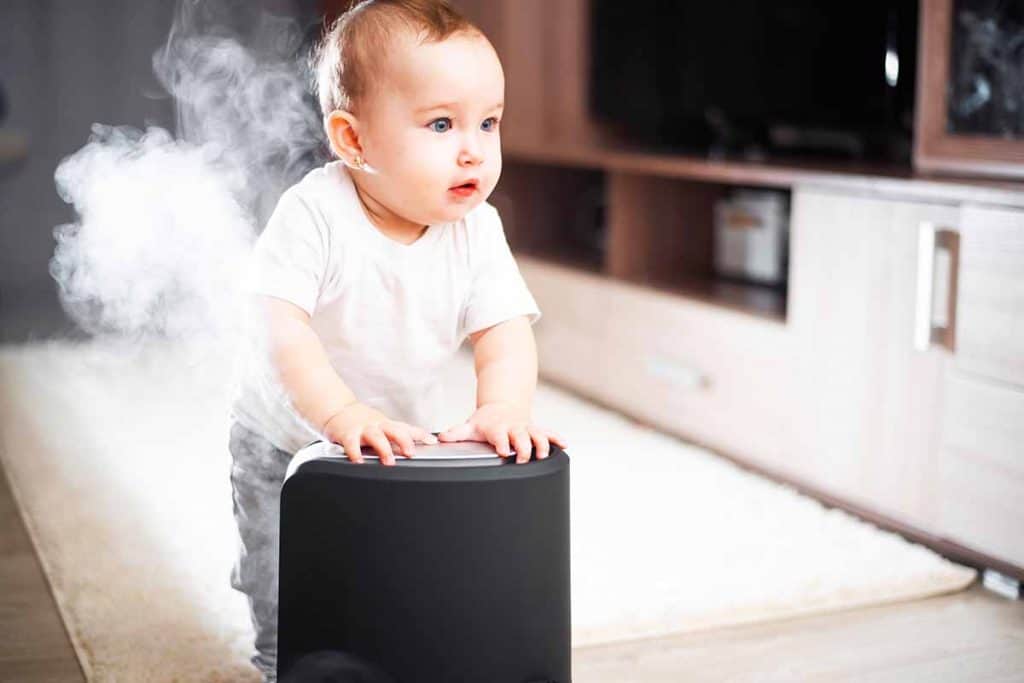The Right Humidifier for You? (5 Types Compared)
We need moisture to survive and thrive. Dry air can have damaging health effects, ranging from general discomfort to skin problems and respiratory conditions.
A humidifier – portable or whole-house-humidifier – is your best defense.
But what type of humidifier is best for your specific needs?

Types of Humidifiers
There are 5 types of humidifiers:
- Steam humidifier (central unit)
- Furnace-mounted bypass humidifier (central unit)
- Power humidifier (essentially a bypass, but with an internal fan)
- Evaporative humidifier (plug-and-play)
- Ultrasonic humidifier (plug-and-play)
Your options narrow to two if you decide to spend minimal amounts of time and money with no installation involved – an evaporative or ultrasonic humidifier.
What is an Evaporative Humidifier?
An evaporative humidifier contains a wick that acts as a filter and provides the surface that absorbs water from the reservoir. An internal fan blows cool air across the filter and vaporizes the water, blowing water vapor into the air. The fan creates noise at higher speeds, which is a common complaint among users.
What is an Ultrasonic Humidifier?
Ultrasonic humidifiers use a diaphragm or transducer that vibrates at a high frequency, converting water in the reservoir into droplets and releasing them into the air as cool mist. They are generally more expensive than evaporative humidifiers but quieter due to their fan-less operation. Their filter-less feature makes maintenance easier.
What is a Bypass Humidifier?
A bypass humidifier attaches to a central heating system, such as the furnace or HVAC system. It operates by utilizing warm air from the furnace to heat and circulate the humidity. The humidifier only runs when the furnace is actively heating. It is the most basic, component-wise, and the least expensive and least efficient of the central humidifiers.
What is a Power Humidifier?
A power humidifier has a built-in fan, which a bypass humidifier does not have, enabling the humidifier to operate independently of the furnace. The fan pulls air across the water panel, forcing water to evaporate. Its humidity output surpasses that of a bypass humidifier.
What is a Steam Humidifier?
Steam humidifiers contain a built-in water tank and a heater that boils the water and converts it into steam. The operation relies on the furnace fan to disperse and circulate humidity throughout your home. They are the most expensive and most efficient central humidifier – ideal for higher humidity (above 50%) and large floor areas (exceeding 4000 sqft).
Benefits of a Humidifier
A humidifier benefits your home or office when the air is dry from the winter cold or dehumidifying effect of the air-conditioning system during summer.
A humidifier provides many benefits:
- Relieves scratchy throat, dry eyes, and dry skin.
- Lessen the symptoms of allergies caused by dryness in the air.
- Soothe the effects of nasal congestion by adding moisture to the air.
- Increases the indoor relative humidity, which improves heat retention and lowers the electricity bill.
- Promotes healthy indoor plant growth.
- Maintains the humidity levels necessary for the protection of furniture and musical instruments.
- Reduces static electricity, which protects electronic equipment.
You can maximize the benefits and help prevent indoor humidity from escaping by strategically placing door draft stoppers under the external doors.

Evaporative vs. Ultrasonic Humidifier
Portable humidifiers are excellent for small homes, offices, and rooms. You have two types to choose from – either evaporative or ultrasonic.
What is the difference between an evaporative and ultrasonic humidifier?
Pros and Cons of Evaporative Humidifier
The evaporative technology is older than the ultrasonic.
| Pros of Evaporative | Cons of Evaporative |
| Cheaper than the ultrasonic. | It can be noisy, depending on fan speed. |
| Can use tap water. Can use in hard water area. | Need to clean and change the wick filter periodically. |
| Available in cool or warm mist, or both. | Lower humidity output rate than the ultrasonic. |
| The boiler for warm mist is a safety hazard. |
Pros and Cons of Ultrasonic Humidifier
The ultrasonic technology is the newer of the two.
| Pros of Ultrasonic | Cons of Ultrasonic |
| Ultra-quiet operation. | More expensive than the evaporative. |
| Uses distilled water, so the air is generally cleaner. | Not advisable to use tap water, so water cost is higher. |
| Only cool mist, so there is no scalding risk. | Lower humidity output rate than the ultrasonic. |
| Higher humidity output than the evaporative. | |
| Filter-less, so it is one less maintenance. |
Evaporative or Ultrasonic Humidifier
They perform the same function but differ in their fundamental design and how they produce water vapor to humidify your space.
How the evaporative and ultrasonic types compare:
| Evaporative | Ultrasonic | |
| Mist Type | Cool or warm. | Cool. |
| Filter | Yes, called a wick. | No. |
| Water Type | Tap water is fine. | Distilled water. |
| Built-in Fan | Yes. | No. |
| Noise Level | Low to high, depending on fan speed. | Quiet. |
| Power Consumption | Higher for warm mist humidifier. | Lower. |
| Maintenance | Wick cleaning or replacement. Water reservoir cleaning. | Water reservoir cleaning. |
| Child-safe | Yes, for cool mist. Avoid warm mist type. | Yes. |
| Price | Cheaper. | More expensive. |

Bypass vs. Steam Humidifier
Bypass and steam humidifiers are central humidifiers that work in conjunction with your HVAC system, depending on the heating system to a certain extent to operate.
How they compare:
| Bypass | Steam | |
| Built-in Boiler | No. | Yes. |
| Operation | It only operates when the heating system runs. | Can run independently of the central heating system. |
| Size | Relatively smaller. | Relatively larger due to the boiler. |
| Power Consumption | Relatively lower. | Relatively higher. |
| Humidity Efficiency | Lower. | Higher. |
| Water Consumption | High. | Low, due to its efficiency. |
| Floor coverage. | Less than 4000 sqft. | More than 4000 sqft. |
| Price | Cheaper. | Considerably more expensive. |
See the best whole house humidifiers review for the appropriately-sized central humidifiers for small, medium, and large houses.
How Much Does It Cost to Install a Whole House Humidifier?
A central whole house humidifier will cost considerably more than portable humidifiers that require no manual installation.
Installing a central whole house humidifier will typically cost anywhere from $200 to $1,000, depending on the humidifier’s cost and who does the installation. A bypass humidifier costs around $200, a fan-powered unit is in the $300 ballpark, and a steam model can cost upwards of $600. If you don’t DIY, you will need to budget a few hours of HVAC work at $50-$80/hour for around $150-$200 in labor costs.
An average central humidifier lasts around ten years, yielding an amortized cost of 5 to 25 cents daily. Installing one is always worth your money in the long run.
How Much Does It Cost to Run a Whole House Humidifier?
The running costs of your whole house humidifier will vary depending on the type you choose.
A bypass humidifier uses negligible amounts of electricity since its heat source is your furnace’s heating element. However, it uses more water – only 20-30% of it evaporates into your ducts. The average steam humidifier uses over 14x the energy of a bypass humidifier, but nearly all the water it uses turns into steam, resulting in less total runtime. A steam humidifier runs without the furnace actively heating, so the comparative costs of running steam vs. bypass unit are fairly similar.
Can You Use a Whole House Humidifier with a Heat Pump?
Another consideration when choosing a whole house humidifier is whether you have a heat pump.
The lower temperature air that the heat pump produces will generally not work well with a bypass-type humidifier. If you have a heat pump, you will need a steam humidifier.
How to Size a Whole House Humidifier?
Sizing a whole house humidifier depends on:
- Floor area or volume to humidify.
- Building envelope insulation quality that seals against heat and moisture loss.
You size humidifier according to the gallons of water per day they can convert into humidity, and size homes by their internal volume, typically in cubic feet.
A 1,600 square foot home with a ten-foot ceiling has an internal volume of 16,000 cubic feet. If the house has an average building envelope (R10-R19 insulation, double pane windows), it needs a humidifier that can produce 13.4 gallons daily.
A humidifier is an equipment that is better to get too big than too small, so always factor in excess capacity to not overstress the humidifier. One to two gallons per thousand cubic feet should suffice to ensure the system does not overwork while keeping you comfortable.

Installing a Whole House Humidifier
Proper installation will ensure your chosen humidifier works as efficiently as possible.
How to Install a Whole House Humidifier?
A bypass whole house humidifier typically works more efficiently if installed on the warm air side of the heater. The warm air will cause more of the water to evaporate.
The installation location matters much less for a steam-type humidifier.
Contrary to common belief, there is no humidity loss if a steam humidifier pushes its humidity into the return side. There is nowhere for the moisture to condense within the furnace. It is a warm system internally, and the humidity will pass through to the other side.
Where is the Best Place to Put It?
Placing a steam whole house humidifier on the warm air side often presents the choice of which trunk line to use: the one supplying the kitchen and dining room or the one feeding into the bedrooms. Your decision, either way, does not make much difference.
Humidity migrates through your house at over 25 feet per second, meaning wherever you install the whole house humidifier, it will feed your entire home.
How Long Does It Take to Install?
Installing a whole house humidifier involves marking the template, cutting holes, and installing the humidifier according to the manufacturer’s instructions. The entire installation process takes between 2-3 hours for an expert HVAC installer.
How Long Does It Take to Work?
The whole house humidifier will take close to 24 hours after installation to get your home up to its appropriate humidity level, depending on current weather conditions and the humidity level you set.
What Level Should You Set It?
A comfortable relative humidity for most homes is between 30% and 50% during non-winter months. The higher end of this range can cause moisture condensation during the dry winter, so around 30% would be appropriate. If unsure, you can leave the whole house humidifier the same as through the other months and turn it down if you notice condensation on the windows.
How to Tell If It Is Working?
After installing and turning on the humidifier, how do you know if it is working?
The first and most obvious sign is how you feel. Your skin should feel less dry, allergies abate, and sinus dryness subsides. Many thermostats include a humidistat that tells you the current relative humidity, and the humidifier you chose may have one included. Alternatively, purchase a hygrometer for $15-$25 to measure humidity more accurately.
How to Clean a Bypass Whole House Humidifier?
You will need to invest some effort into maintenance to keep your whole house humidifier working well over the long haul.
Worry not. It is not nearly as involved as the maintenance of your heater or air conditioning system, and you should be able to accomplish most tasks on your own.
If you are uncomfortable doing DIY, hiring a professional once a year will cost $70-$100 in most cases.
To maintain a bypass whole house humidifier:
- Turn off the power and water to the furnace.
- Remove the outer cover to expose the internal parts and moisture wicking pad.
- If the pad looks relatively clean (mostly clear of hard water deposits), clean it by soaking in a 1:3 water to vinegar solution until the deposits dissolve, rinse with clean water, and replace it into the unit.
- Replace the evaporative pad annually or when the mineral deposits become too significant to soak away.
- Clean any mineral deposits from within the humidifier.
- Reassemble, and turn the power and water back on.
How to Clean a Steam Whole House Humidifier?
Cleaning a steam whole home humidifier is a similar process:
- Turn off the furnace.
- Turn off the water and power supply to the humidifier; wait for it to cool.
- Remove the overflow pan and check the drain tube to make sure it is clear.
- Clean any parts to which you have access, using a 1:3 water to vinegar solution to dissolve the mineral deposits.
- There may be an inline water filter that you need to replace, depending on your humidifier – check the product manual.
- Reassemble (be careful of any O-rings that might be present).
- Turn the water, power, and furnace back on.
How to Prevent Mold in a Whole House Humidifier?
Any water appliance carries mold risks.
Excessive moisture in the humidifier ductwork can cause mold to grow and spread throughout your home, but some sensible guidelines can help mitigate this danger.
Humidifier mold prevention:
- If you see moisture on your windows, turn down the humidifier.
- Ventilate the house interiors regularly.
- Insulate the duct system.
- Inspect the evaporative pad every season, and clean or change as needed.
- Use a furnace filter with a minimum rating of MERV 6 and replace it every 3-6 months, at a minimum.
- Clean the furnace or HVAC system every 2-3 years.
Absolute Humidity vs. Relative Humidity
On the subject of humidifiers, it is essential to differentiate between the two terms or, at least, know the correct term to refer to.
What is the difference between absolute humidity and relative humidity?
Absolute humidity is the amount of water vapor contained within a given air volume, regardless of temperature, often expressed in g/m3 or g/kg. Relative humidity, expressed as a %, is the ratio of water vapor to the air’s saturation point at a given pressure and temperature.
The humidity level that humidifiers achieve refers to the relative humidity in % term.

What Type of Humidifier is Best for You?
The short answer:
A steam humidifier is the best type, purely from an efficiency standpoint. It heats the water independently of the furnace or HVAC’s heating element, unlike a bypass humidifier which siphons warm air from the furnace to heat and circulate moisture, resulting in lower efficiency. Portable humidifiers are cheaper to buy, but the humidity they achieve rarely exceeds 40%.
The steam type is an excellent humidifier, but it is also the most expensive. Another type may be the better option for you, depending on your needs.
The in-depth review of the Best Whole House Humidifiers identifies the appropriate humidifier to suit your specific requirement.
Best for Allergies and General Dryness for the Eyes, Nose, Skin, and Throat?
The ideal humidity in the house is between 30% and 50%. All types of humidifiers can help you achieve this, but several factors will affect your choice.
If air dryness has long-term effects on your eyes, nose, skin, or throat, central steam humidifiers are the ideal choice. They are more effective in maintaining your desired humidity level and distributing it evenly throughout the house. Alternatively, choose an evaporative warm or cool mist portable humidifier for individual rooms as the more affordable option.
Best for Babies?
Babies have delicate skins, and it is not difficult to imagine that the effects of dry air are harsher on them than on adults.
Babies and toddlers need a comfortable and quiet environment for sleeping, and an ultrasonic cool mist humidifier is the best type for them. An ultrasonic humidifier’s operation does not involve a fan, eliminating the noise problem commonly associated with evaporative humidifiers.
Best for Plants?
Plants need water to survive, and humid air helps maintain the moisture in their leaves.
The obvious signs that your plants suffer from low humidity levels include wilting foliage, browning leaves, leaf curl, and spindly growth.
Plants need humidity levels between 40% to 60%, and the type of humidifier you use depends on how large a floor area they occupy. A steam or furnace-mounted central humidifier can cover a larger space at the required humidity level. In contrast, an evaporative humidifier is more cost-effective for indoor plants confined within a smaller room.
Portable humidifiers typically struggle to achieve the humidity levels that plants require to thrive due to their smaller capacity, so placing the humidifier closer to them will help.
Best for a Bedroom?
The summer and winter months can wreak havoc on your sleep. The winter air is dry, and air-conditioning during summer sucks the humidity out of the indoor air, causing you to wake up parched or experiencing respiratory issues.
What type of humidifier is best for a bedroom?
The ideal sleeping environment is dark, quiet, and a comfortable humidity level. Choose an ultrasonic humidifier for your bedroom as it is ultra-quiet and humidifies the room just as well as the evaporative type. A humidifier that does not have an LED light that switches on when the humidifier operates is preferable.
